Beko CH142100 DS, CH146100 D, CH142100 DX, CH142120 DPX User manual [EN,DE,FR,NL]
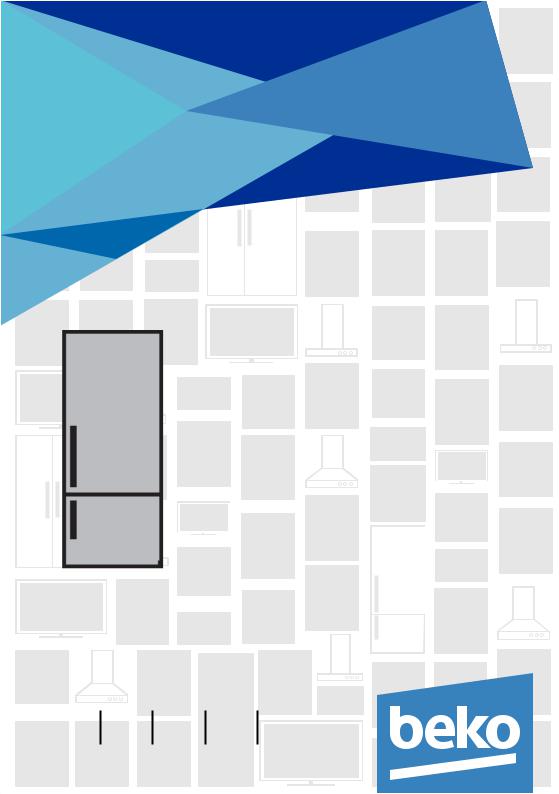
Refrigerator |
|||
User manual |
|||
|
|
Kühlschrank/Gefrierschrank |
|
|
|
Bedienungsanleitung |
|
|
|
Réfrigérateur |
|
|
|
Manuel d'utilisation |
|
|
|
Koelkast |
|
|
|
Gebruiksaanwijzing |
|
|
|
CH142100 DS |
|
|
|
CH146100 D |
|
|
|
CH142100 DX |
|
|
|
CH142120 DPX |
|
EWWERQWEW |
DE |
FR |
NL |
EN |
|||
Please read this user manual first!
Dear Customer,
We hope that your product, which has been produced in modern plants and checked under the most meticulous quality control procedures, will provide you an effective service.
Therefore, read this entire user manual carefully before using the product and keep it as a reference. If you handover the product to someone else, give the user manual as well.
The user manual will help you use the product in a fast and safe way.
•Read the manual before installing and operating the product.
•Make sure you read the safety instructions.
•Keep the manual in an easily accessible place as you may need it later.
•Read the other documents given with the product.
Remember that this user manual is also applicable for several other models. Differences between models will be identified in the manual.
Explanation of symbols
Throughout this user manual the following symbols are used:
CImportant information or useful tips.
AWarning against dangerous conditions for life and property. BWarning against electric voltage.

CONTENTS
1 Your refrigerator |
3 |
2 Important Safety |
|
Warnings |
4 |
Intended use................................................ |
4 |
General safety............................................. |
4 |
For products with a .................................. |
7 |
water dispenser;........................................ |
7 |
Child safety................................................... |
7 |
Compliance with WEEE Directive and |
|
Disposing of the Waste Product: ........ |
8 |
Package information................................. |
8 |
HC warning................................................... |
8 |
Things to be done for energy saving.9 |
|
4 Preparation |
15 |
5 Using your refrigerator |
16 |
Thermostat setting button................. |
16 |
Defrost......................................................... |
16 |
Water Dispenser....................................... |
17 |
*May not be available in all models..17 |
|
6 Maintenance and |
|
cleaning |
19 |
Protection of plastic surfaces ............ |
19 |
7 Troubleshooting |
20 |
3 Installation |
10 |
Points to be paid attention to when |
|
the relocation of the refrigerator...... |
10 |
Electrical connection.............................. |
10 |
Disposing of the packaging................. |
11 |
Disposing of your old refrigerator..... |
11 |
Placing and Installation......................... |
11 |
Adjusting the legs.................................... |
12 |
Installing the lower ventilation |
|
cover.............................................................. |
12 |
Changing the illumination lamp ........ |
12 |
Turbo Cooling Fan.................................... |
13 |
Icematic and ice storage container... |
13 |
Reversing the doors................................ |
14 |
2 EN
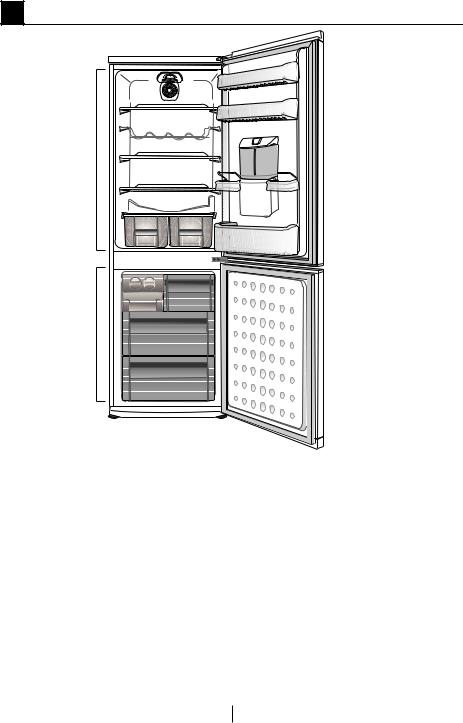
1 Your refrigerator
1 |
|
|
2 |
14 |
|
3 |
||
4 |
13 |
|
|
||
15 |
|
|
17 |
16 |
|
6 |
5 |
|
15 |
||
7 |
||
|
||
8 |
9 |
|
|
||
18 |
|
|
10 |
|
|
11 |
|
|
12 |
|
1. |
Interior light |
10.Freezer compartment |
2. |
Thermostat knob |
11.Air grille |
3. |
Fan |
12.Adjustable front feet |
4. |
Adjustable body shelves |
13.Adjustable door shelves |
5. |
Defrost water collection channel - |
14.Egg holders |
|
Drain tube |
15.Bottle shelf |
6. |
Crisper cover |
16.Water dispenser |
7. |
Salad crisper |
17.Fridge compartment |
8. |
Ice bank |
18.Freezer compartment |
9. |
Icebank tray |
|
C Figures that take place in this instruction manual are schematic and may not correspond exactly with your product. If the subject parts are not included in the product you have purchased, then it is valid for other models.
3 EN

2 Important Safety Warnings
Please review the following information. Failure to observe this information may cause injuries or material damage. Otherwise, all warranty and reliability commitments will become invalid.
Original spare parts will be provided for 10 years, following the product purchasing date.
Intended use
|
|
|
|
|
||
|
WARNING: |
ventilation |
||||
|
Keep |
|
||||
A |
openings, |
|
in |
|
the |
|
|
appliance |
enclosure |
or |
|||
|
in the built-in structure, |
|||||
|
clear of obstruction. |
|
||||
|
WARNING: |
|
|
|
||
|
Do not use mechanical |
|||||
|
devices or other means |
|||||
A |
to |
accelerate |
the |
|||
|
d e f ro s t i n g p ro c e s s , |
|||||
|
other |
than |
those |
|||
|
recommended |
by |
the |
|||
|
manufacturer. |
|
|
|||
|
WARNING: |
|
|
|
||
A |
Do |
not |
damage the |
|||
|
refrigerant circuit. |
|
||||
|
WARNING: |
|
|
|
||
|
Do not |
use electrical |
||||
|
appliances |
|
inside |
|||
|
the |
food |
|
storage |
||
A |
compartments |
|
of |
|||
|
the |
appliance, |
unless |
|||
|
they are of the type |
|||||
|
recommended |
by |
the |
|||
|
manufacturer. |
|
|
|||
WARNING:
Do not store explosive A substances such as aerosol cans with a flammable propellant in
this appliance.
This |
appliance is |
intended |
to be used in household and |
||
similar applications such as |
||
– staff kitchen areas in shops, |
||
offices |
and other |
working |
environments;
– farm houses and by clients in hotels, motels and other residential type environments;
– bed and breakfast type environments;
– catering and similar non-retail applications.
General safety
•When you want to dispose/ scrap the product, we recommend you to consult the authorized service in order to learn the required information and authorized bodies.
•Consult your authorized service for all your questions and problems related to the refrigerator. Do not intervene or let someone intervene
to the refrigerator without notifying the authorised services.
•For products with a freezer compartment; Do not eat cone ice cream and ice cubes immediately after
4 EN

you take them out of the freezer compartment! (This may cause frostbite in your mouth.)
•For products with a freezer compartment; Do not put bottled and canned liquid beverages in the freezer compartment. Otherwise, these may burst.
•Do not touch frozen food by hand; they may stick to your hand.
•Unplug your refrigerator before cleaning or defrosting.
•Vapor and vaporized cleaning materials should never
be used in cleaning and defrosting processes of your refrigerator. In such cases, the vapor may get in contact with the electrical parts and cause short circuit or electric shock.
•Never use the parts on your refrigerator such as the door as a means of support or step.
•Do not use electrical devices inside the refrigerator.
•Do not damage the parts, where the refrigerant is circulating, with drilling or cutting tools. The refrigerant that might blow out when the gas channels of the evaporator, pipe extensions or surface coatings are punctured causes skin irritations and eye injuries.
•Do not cover or block the ventilation holes on your refrigerator with any material.
•Electrical devices must be repaired by only authorised persons. Repairs performed by incompetent persons create a risk for the user.
•In case of any failure or during a maintenance or repair work, disconnect your refrigerator’s mains supply by either turning off the relevant fuse or unplugging your appliance.
•Do not pull by the cable when pulling off the plug.
•Ensure highly alcoholic beverages are stored securely with the lid fastened and placed upright.
•Never store spray cans containing flammable and explosive substances in the refrigerator.
•Do not use mechanical devices or other means to accelerate the defrosting process, other than those recommended by the manufacturer.
•This product is not intended to be used by persons with physical, sensory or mental disorders or unlearned
or inexperienced people (including children) unless they are attended by a person who will be responsible
for their safety or who will instruct them accordingly for use of the product
•Do not operate a damaged refrigerator. Consult with the service agent if you have any concerns.
5 EN

•Electrical safety of your refrigerator shall be guaranteed only if the earth system in your house complies with standards.
•Exposing the product to rain, snow, sun and wind is dangerous with respect to electrical safety.
•Contact authorized service when there is a power cable damage to avoid danger.
•Never plug the refrigerator into the wall outlet during installation. Otherwise, risk of death or serious injury may arise.
•This refrigerator is intended for only storing food items. It must not be used for any other purpose.
•Label of technical specifications is located on the left wall inside the refrigerator.
•Never connect your refrigerator to electricitysaving systems; they may damage the refrigerator.
•If there is a blue light on the refrigerator, do not look at the blue light with optical tools.
•For manually controlled refrigerators, wait for at least 5 minutes to start the refrigerator after power failure.
•This operation manual should be handed in to the new owner of the product when it is given to others.
6
•Avoid causing damage on power cable when
transporting the refrigerator. Bending cable may cause fire. Never place heavy objects on power cable. Do not touch the plug with wet hands when plugging the product
•Do not plug the refrigerator if the wall outlet is loose.
•Water should not be sprayed on inner or outer parts of the product for safety purposes.
•Do not spray substances containing inflammable gases such as propane gas near the refrigerator to avoid fire and explosion risk.
•Never place containers filled with water on top of the refrigerator; in the event of spillages, this may cause electric shock or fire.
•Do not overload the refrigerator with food. If overloaded, the food items may fall down and hurt you and damage refrigerator when you open the door.
•Never place objects on top of the refrigerator; otherwise, these objects may fall down when you open or close the refrigerator’s door.
EN
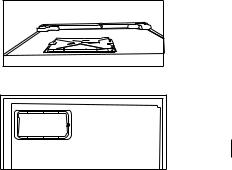
•As they require a precise temperature, vaccines, heat-sensitive medicine and scientific materials and etc. should not be kept in the refrigerator.
•If not to be used for a long time, refrigerator should be unplugged. A possible problem in power cable may cause fire.
•Refrigerator may move if adjustable legs are not
properly secured on the floor. Properly securing adjustable legs on the floor can prevent the refrigerator to move.
•When carrying the refrigerator, do not hold it from door handle. Otherwise, it may be snapped.
•When you have to place your product next to another refrigerator or freezer, the distance between devices should be at least 8cm. Otherwise, adjacent side walls may be humidified.
•The product shall never be used while the compartment which is located at the top or back of your product and in which electronic boards are available (electronic board box cover) (1) is open.
1 |
For products with a water dispenser;
•Pressure for cold water inlet shall be maximum 90 psi (6.2 bar). If your water pressure exceeds 80 psi (5.5 bar), use a pressure limiting valve in your mains system. If you do not know how to check your water pressure, ask for the help of a professional plumber.
•If there is risk of water hammer effect in your installation, always use a water hammer
prevention equipment in your installation. Consult Professional plumbers is you are not sure that there is no water hammer effect in your installation.
•Do not install on the hot water inlet. Take precautions against of the risk of freezing of the hoses. Water temperature operating interval shall be 33°F (0.6°C) minimum and 100°F (38°C) maximum.
•Use only potable water.
Child safety
•If the door has a lock, the key should be kept away from reach of children.
•Children must be supervised to prevent them from tampering with the product.
1
7 EN

Compliance with WEEE Directive and Disposing of the Waste Product:
This product complies
with EU WEEE Directive (2012/19/ EU). This product bears a classification symbol for waste electrical and
electronic equipment (WEEE). This product has been manufactured with high quality parts and materials which can be reused and are suitable for recycling. Therefore, do not dispose the product with normal domestic waste at the end of its service life. Take it to a collection point for the recycling of electrical and electronic equipment. Please consult your local authorities to learn the nearest collection point. Help protect the environment and natural resources by recycling used products. For children’s safety, cut the power cable and break the locking mechanism of the door, if any, so that it will be non-functional before disposing of the product.
Package information
Packaging materials of the product are manufactured from recyclable materials in accordance with our National Environment Regulations. Do not dispose of the packaging materials together with the domestic or other wastes. Take them to the packaging material
collection points designated by the local authorities.
Do not forget...
Any recycled substance is an indispensable matter for nature and our national asset wealth.
If you want to contribute to the re-evaluation of the packaging materials,youcanconsulttoyour environmentalist organizations or the municipalities where you are located.
HC warning
If your product's cooling system contains R600a:
This gas is flammable. Therefore, pay attention to not damaging the cooling system and piping during usage and transportation. In the event of damage, keep your product away from potential fire sources that can cause the product catch a fire and ventilate the room in which the unit is placed.
Ignore this warning if your product's cooling system contains R134a.
Type of gas used in the product is stated in the type label which is on the left wall inside the refrigerator.
Never throw the product in fire for disposal.
8 EN

Things to be done for energy saving
•Do not leave the doors of your refrigerator open for a long time.
•Do not put hot food or drinks in your refrigerator.
•Do not overload your refrigerator so that the air circulation inside of it is not prevented.
•Do not install your refrigerator under direct sunlight or near heat emitting appliances such as ovens, dishwashers or radiators. Keep your refrigerator at least 30cm away from heat emitting sources and at least 5cm from electrical ovens.
•Pay attention to keep your food in closed containers.
•For products with a freezer compartment; You can store maximum amount of food items in the freezer when you remove the shelf or drawer of the freezer. Energy consumption value stated for your refrigerator has been
determined by removing freezer shelf or drawer and under maximum load. There is no harm to use a shelf
or drawer according to the shapes and size of food to be frozen.
•Thawing frozen food in fridge compartment will both provide energy saving and preserve the food quality.
9 EN

3 Installation
BIn case the information which are given in the user manual are not taken into account, manufacturer will not assume any liability for this.
Points to be paid attention to when the relocation of the refrigerator
1.Your refrigerator should be unplugged.Before transportation of your refrigerator, it should be emptied and cleaned.
2.Before it is re-packaged, shelves, accessories, crisper, etc. inside your refrigerator should be fixed with adhesive tape and secured against impacts. Package should be bound with a thick tape or sound ropes and the transportation rules on the package should be strictly observed.
3.Original packaging and foam materials should be kept for future transportations or moving.
Before you start the refrigerator,
Check the following before you start to use your refrigerator:
1. Attach 2 plastic wedges as illustrated below. Plastic wedges are intended to keep the distance which will ensure the air circulation between your refrigerator and the wall. (The picture is drawn up as a representation and it is not identical with your product.)
2. Clean the interior of the refrigerator as recommended in the “Maintenance and cleaning” section.
3. Connect the plug of the refrigerator to the wall socket. When the fridge door is opened, fridge
internal lamp will turn on.
10
4.When the compressor starts to operate, a sound will be heard. The liquid and gases sealed within the refrigeration system may also give rise to noise, even if the compressor is not running and this is quite normal.
5.Front edges of the refrigerator may feel warm. This is normal. These areas are designed to be warm to avoid condensation.
Electrical connection
Connect your product to a grounded socket which is being protected by a fuse with the appropriate capacity.
Important:
The connection must be in compliance with national regulations.
•The power plug must be easily accessible after installation.
•Electrical safety of your refrigerator shall be guaranteed only if the earth system in your house complies with standards.
•The voltage stated on the label located at left inner side of your product should be equal to your network voltage.
•Extension cables and multi plugs must not be used for connection.
EN

BA damaged power cable must be replaced by a qualified electrician.
BProduct must not be operated before it is repaired! There is the risk of electric shock!
Disposing of the packaging
The packing materials may be dangerous for children. Keep the packing materials out of the reach of children or dispose of them by classifying them in accordance with the waste instructions stated by your local authorities. Do not throw away with regular house waste, throw away on packaging pick up spots designated by the local authorities.
The packing of your refrigerator is produced from recyclable materials.
Disposing of your old refrigerator
Dispose of your old refrigerator without giving any harm to the environment.
•You may consult your authorized dealer or waste collection center of your municipality about the disposal of your refrigerator.
Before disposing of your refrigerator, cut out the electric plug and, if there are any locks on the door, make them inoperable in order to protect children against any danger.
Placing and Installation
A If the entrance door of the room where the refrigerator will be installed is not wide enough for the refrigerator to pass through, then call the authorized service to have them remove the doors of your refrigerator and pass it sideways through the door.
1.Install your refrigerator to a place that allows ease of use.
2.Keep your refrigerator away from heat sources, humid places and direct sunlight.
3.There must be appropriate air ventilation around your refrigerator in order to achieve an efficient operation. If the refrigerator is to be placed in a recess in the wall, there must be at least 5 cm distance with the ceiling and at least 5 cm with the wall. Do not place your product on the materials such as rug or carpet.
4.Place your refrigerator on an even floor surface to prevent jolts.
11 EN
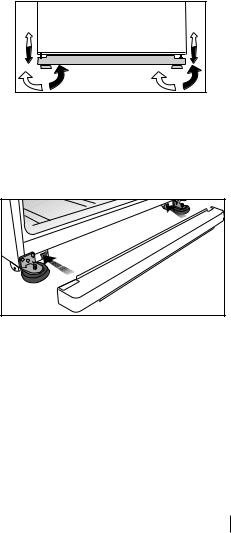
Adjusting the legs
If your refrigerator is unbalanced; You can balance your refrigerator
by turning its front legs as illustrated in the figure. The corner where the leg exists is lowered when you turn in the direction of black arrow and raised when you turn in the opposite direction. Taking help from someone to slightly lift the refrigerator will facilitate this process.
Changing the illumination lamp
To change the Bulb/LED used for illumination of your refrigerator, call your AuthorisedService.
The lamp(s) used in this appliance is not suitable for household room illumination. The intended purpose of this lamp is to assist the user to place foodstuffs in the refrigerator/ freezer in a safe and comfortable way.The lamps used in this appliance have to withstand extreme physical conditions such as temperatures below -20 °C.
(only chest and upright freezer)
Installing the lower ventilation cover
You can install the lower ventilation cover as illustrated in the figure.
12 EN
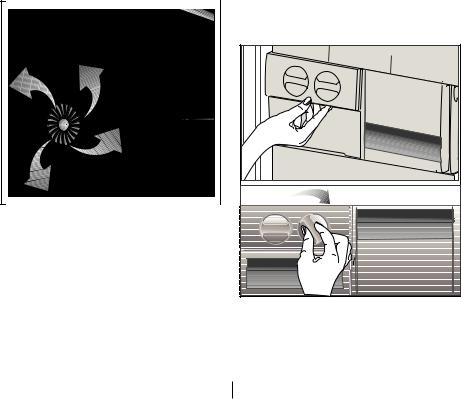
Turbo Cooling Fan
“Turbo cooling fan is designed to ensure homogenous distribution and circulation of the cold air inside your refrigerator. Operation time of the turbo cooling fan may vary depending on the properties of your product. While the turbo fan works only with the compressor in some products, the control system determines its operation time in some products in accordance with the cooling requirement. This situation is explained on a separate warning and information label attached on the refrigerator in products equipped with turbo fans running under different conditions than the compressor.”
Icematic and ice storage container
*May not be available in all models Using the Icematic
Fill the Icematic with water and place it into its seat. Your ice will be ready approximately in two hours. Do not remove the Icematic from its seating to take ice.
Turn the knobs on the ice reservoirs clockwise by 90 degrees.
Ice cubes in the reservoirs will fall down into the ice storage container below.
You may take out the ice storage container and serve the ice cubes.
If you wish, you may keep the ice cubes in the ice storage container.
Ice storage container
Ice storage container is only intended for accumulating the ice cubes. Do not put water in it. Otherwise, it will break.
13 EN
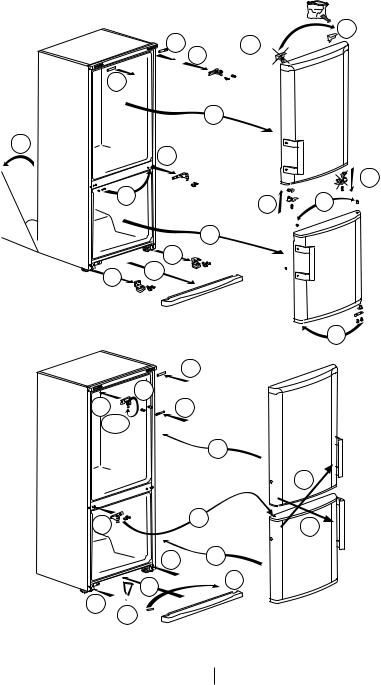
Reversing the doors
Proceed in numerical order
4
8
45°
9
21
4 |
|
11 |
5 |
11 |
|
|
|
2
1
12
6 |
13 |
14 |
|
3
10 7
15
22
20
22
180°
|
|
25 |
|
|
27 |
26 |
24 |
27 |
|
17 23
19 






 18
18
19






16
14 EN

4 Preparation
•Your refrigerator should be installed at least 30 cm away from heat sources such as hobs, ovens, central heater and stoves and at least 5 cm away from electrical ovens and should not be located under direct sunlight.
•The ambient temperature of the room where you install your refrigerator should at least be 10°C. Operating your refrigerator under cooler conditions is not recommended with regard to its efficiency.
•Please make sure that the interior of your refrigerator is cleaned thoroughly.
•If two refrigerators are to be installed side by side, there should be at least 2 cm distance between them.
•When you operate your refrigerator for the first time, please observe the following instructions during the initial six hours.
•The door should not be opened frequently.
•It must be operated empty without any food in it.
•Do not unplug your refrigerator. If a power failure occurs out of your control, please see the warnings in the “Recommended solutions for the problems” section.
•Original packaging and foam materials should be kept for future transportations or moving.
•The baskets/drawers that are provided with the chill compartment must always be in use for low energy consumption and for better storage conditions.
•Food contact with the temperature sensor in the freezer compartment may increase energy consumption of the appliance. Thus any contact with the sensor(s) must be avoided.
•In some models, the instrument panel automatically turns off 5 minutes after the door has closed. It will be reactivated when the door has opened or pressed on any key.
•Due to temperature change as a result of opening/closing the product door during operation, condensation on the door/body
shelves and the glass containers is normal
15 EN
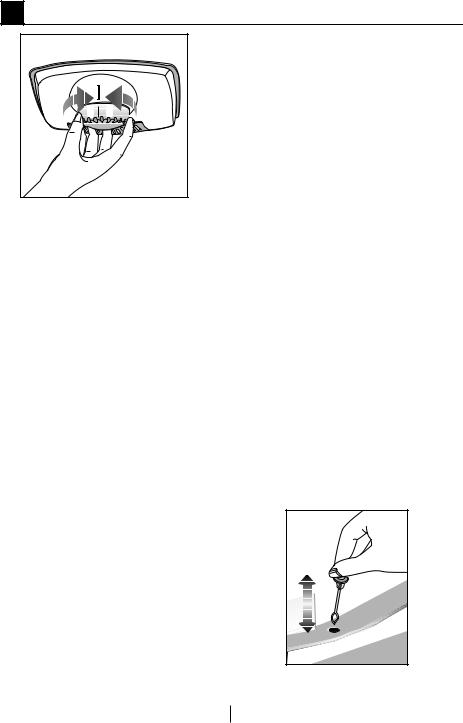
5 Using your refrigerator
Thermostat setting button
The interior temperature of your refrigerator changes for the following reasons;
•Seasonaltemperatures,
•Frequentopeningofthedoorand leaving the door open for long periods,
•Foodputintotherefrigerator without cooling down to the room temperature,
•Thelocationoftherefrigeratorin the room (e.g. exposing to sunlight).
•Youmayadjustthevaryinginterior temperature due to such reasons by using the thermostat. Numbers around the thermostat button indicates the cooling degrees.
•Iftheambienttemperatureishigher than 32°C, turn the thermostat button to maximum position.
•Iftheambienttemperatureislower than 25°C, turn the thermostat button to minimum position.
Defrost
Fridge compartment
Fridge compartment performs fullautomatic defrosting. Water drops and a frosting up to 7-8 mm can occur on the inner rear wall of the fridge compartment while your refrigerator cools down. Such formation is normal as a result of the cooling system. The frost formation is defrosted by performing automatic defrosting with certain intervals thanks to the automatic defrosting system of the rear wall. User is not required to scrape the frost or remove the water drops.
Water resulting from the defrosting passes from the water collection groove and flows into the evaporator through the drain pipe and evaporates here by itself.
Check regularly to see if the drain pipe is clogged or not and clear it with the stick in the hole when necessary.
Deep freezer compartment does not perform automatic defrosting in order to prevent decaying of the frozen food.
The freezer compartment defrosts automatically.
16 EN

Water Dispenser
*May not be available in all models
The water dispenser is a very useful feature allowing cold water on tap without opening the door of your refrigerator .As you will not have to open your refrigerator door frequently, you will have saved energy.
Using the water dispenser
Push the lever of the water dispenser with your glass. The dispenser will cease operating once you release the lever.
When operating the water dispenser, maximum flow can be obtained by pressing the lever fully. Please remember that the amount of flow from the dispenser is subject to the degree you press the lever.
As the level of the water in your glass/container rises, slightly lessen the pressure on the lever to prevent the overspill. If you slightly press the lever, the water will drip; this is quite normal and not a failure.
Filling the water dispenser's tank
Open the cover of the water tank as shown in the figure. Fill in the pure and clean drinking water. Close the cover.
To avoid flowing of water by mistake, we recommend you to lock the water dispenser .
Warning!
•Do not fill the water tank with any other liquid except for water such as fruit juices, carbonated
beverages or alcoholic drinks which are not suitable to use in the water dispenser. Water dispenser will
be irreparably damaged if these kinds of liquids are used. Warranty does not cover such usages. Some chemical substances and additives contained in these kinds of drinks/ liquids may damage the water tank.
•Use clean and pure drinking water only.
•Capacity of the water tank is 2.2 Litres (3.8 pints); do not overfill.
17 EN
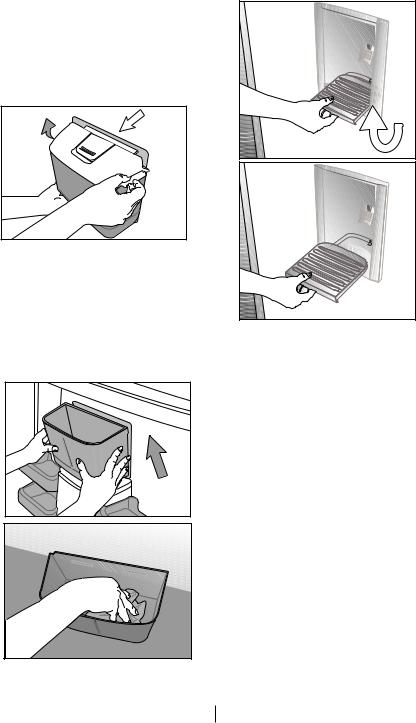
•Push the arm of the water dispenser with a rigid glass. If you are using disposable plastic glasses, push the lever with your fingers from behind the glass.
1  2
2
 1
1
Cleaning the water tank
Release the tank cover from the water tank by opening latches at both sides. Remove the water tank and clean with warm and clean water. Place the water tank to its seating, install the tank cover and close the latches.
3 |
Make sure that the parts removed (if any) during cleaning are properly attached to their original places. Otherwise, water leakage may occur.
Important:
Components of the water tank and water dispenser should not be washed in dishwasher.
Water tray
Water that dripped while using the water dispenser accumulates in the spillage tray. Take out the spillage tray by pulling it towards yourself and empty it regularly.
Take out the plastic strainer by pressing it on sides.
Take the water valve out of the water tank. When replacing it, make sure that the seal is in place.
18 EN

|
|
Maintenance and cleaning |
||
|
6 |
|||
|
A |
Never use gasoline, benzene or |
C Check door seals regularly to ensure |
|
|
similar substances for cleaning |
they are clean and free from food |
||
|
purposes. |
particles. |
||
B We recommend that you unplug the |
A To remove door racks, remove all the |
|||
|
appliance before cleaning. |
contents and then simply push the |
||
B Never use any sharp abrasive |
door rack upwards from the base. |
|||
|
instrument, soap, household |
A Never use cleaning agents or water |
||
|
cleaner, detergent and wax polish |
that contain chlorine to clean the |
||
|
for cleaning. |
outer surfaces and chromium coated |
||
B For non-No Frost products, |
parts of the product. Chlorine causes |
|||
|
water drops and frosting up to a |
corrosion on such metal surfaces. |
||
|
fingerbreadth occur on the rear wall |
A Do not use sharp, abrasive tools, |
||
|
of the Fridge compartment. Do not |
soap, household cleaning agents, |
||
|
clean it; never apply oil or similar |
detergents, kerosene, fuel oil, |
||
|
agents on it. |
varnish etc. to prevent removal and |
||
B Only use slightly damp microfiber |
deformation of the prints on the |
|||
|
cloths to clean the outer surface |
plastic part. Use lukewarm water |
||
|
of the product. Sponges and other |
and a soft cloth for cleaning and |
||
|
types of cleaning cloths may scratch |
then wipe it dry. |
||
|
the surface. |
Protection of plastic |
||
|
cabinet of your refrigerator and wipe |
surfaces |
||
C Use lukewarm water to clean the |
|
|||
|
it dry. |
C Do not put the liquid oils or oil- |
||
C Use a damp cloth wrung out in |
cooked meals in your refrigerator |
|||
in unsealed containers as they |
||||
|
a solution of one teaspoon of |
|||
|
damage the plastic surfaces of your |
|||
|
bicarbonate of soda to one pint of |
|||
|
refrigerator. In case of spilling or |
|||
|
water to clean the interior and wipe |
|||
|
smearing oil on the plastic surfaces, |
|||
|
it dry. |
|||
|
clean and rinse the relevant part |
|||
B Make sure that no water enters the |
of the surface at once with warm |
|||
|
lamp housing and other electrical |
water. |
||
items.
B If your refrigerator is not going to be used for a long period of time, unplug the power cable, remove all food, clean it and leave the door ajar.
19 EN

7. Troubleshooting
Check this list before contacting the service. Doing so will save you time and money. This list includes frequent complaints that are not related to faulty workmanship or materials. Certain features mentioned herein may not apply to your product.
The refrigerator is not working.
•The power plug is not fully settled. >>>
Plug it in to settle completely into the socket.
•The fuse connected to the socket powering the product or the main fuse is blown. >>> Check the fuses.
Condensation on the side wall of the cooler compartment (MULTI ZONE, COOL, CONTROL and FLEXI ZONE).
•The door is opened too frequently >>>
Take care not to open the product’s door too frequently.
•The environment is too humid. >>>
Do not install the product in humid environments.
•Foods containing liquids are kept in unsealed holders. >>> Keep the foods containing liquids in sealed holders.
•The product’s door is left open. >>>
Do not keep the product’s door open for long periods.
•The thermostat is set to too low temperature. >>> Set the thermostat to appropriate temperature.
Compressor is not working.
•In case of sudden power failure or pulling the power plug off and
putting back on, the gas pressure in the product’s cooling system is not
balanced, which triggers the compressor thermic safeguard. The product will restart after approximately 6 minutes.
If the product does not restart after this period, contact the service.
•Defrosting is active. >>> This is normal for a fully-automatic defrosting product. The defrosting is carried out periodically.
•The product is not plugged in. >>> Make sure the power cord is plugged in.
•The temperature setting is incorrect.
>>> Select the appropriate temperature setting.
•The power is out. >>> The product will continue to operate normally once the power is restored.
The refrigerator’s operating noise is increasing while in use.
•The product’s operating performance may vary depending on the ambient temperature variations. This is normal and not a malfunction.
The refrigerator runs too often or for too long.
•The new product may be larger than the previous one. Larger products will run for longer periods.
•The room temperature may be high. >>>
The product will normally run for long periods in higher room temperature.
•The product may have been recently plugged in or a new food item is placed inside. >>> The product will take longer to reach the set temperature when recently plugged in or a new food item is placed inside. This is normal.
•Large quantities of hot food may have been recently placed into the product.
>>> Do not place hot food into the product.
•The doors were opened frequently or kept open for long periods. >>> The warm air moving inside will cause the product to run longer. Do not open the doors too frequently.
20 EN

•The freezer or cooler door may be ajar.
>>> Check that the doors are fully closed.
•The product may be set to temperature too low. >>> Set the temperature to a higher degree and wait for the product to reach the adjusted temperature.
•The cooler or freezer door washer may be dirty, worn out, broken or not properly settled. >>> Clean or replace the washer. Damaged / torn door
washer will cause the product to run for longer periods to preserve the current temperature.
The freezer temperature is very low, but the cooler temperature is adequate.
•The freezer compartment temperature is set to a very low degree. >>> Set the freezer compartment temperature to a higher degree and check again.
The cooler temperature is very low, but the freezer temperature is adequate.
•The cooler compartment temperature is set to a very low degree. >>> Set the freezer compartment temperature to a higher degree and check again.
The food items kept in cooler compartment drawers are frozen.
•The cooler compartment temperature is set to a very low degree. >>> Set the freezer compartment temperature to a higher degree and check again.
The temperature in the cooler or the freezer is too high.
•The cooler compartment temperature is set to a very high degree. >>>
Temperature setting of the cooler compartment has an effect on the temperature in the freezer
compartment. Wait until the temperature of relevant parts reach the sufficient
level by changing the temperature of cooler or freezer compartments.
•The doors were opened frequently or kept open for long periods. >>> Do not open the doors too frequently.
•The door may be ajar. >>> Fully close the door.
•The product may have been recently plugged in or a new food item is placed inside. >>> This is normal. The product will take longer to reach the set
temperature when recently plugged in or a new food item is placed inside.
•Large quantities of hot food may have been recently placed into the product.
>>> Do not place hot food into the product.
Shaking or noise.
•The ground is not level or durable. >>>
If the product is shaking when moved slowly, adjust the stands to balance the product. Also make sure the ground is sufficiently durable to bear the product.
•Any items placed on the product may cause noise. >>> Remove any items placed on the product.
The product is making noise of liquid flowing, spraying etc.
•The product’s operating principles involve liquid and gas flows. >>> This is normal and not a malfunction.
There is sound of wind blowing coming from the product.
•The product uses a fan for the cooling process. This is normal and not a malfunction.
There is condensation on the product’s internal walls.
•Hot or humid weather will increase icing and condensation. This is normal and not a malfunction.
21 EN

•The doors were opened frequently or kept open for long periods. >>> Do not open the doors too frequently; if open, close the door.
•The door may be ajar. >>> Fully close the door.
There is condensation on the product’s exterior or between the doors.
•The ambient weather may be humid, this is quite normal in humid weather.
>>> The condensation will dissipate when the humidity is reduced.
The interior smells bad.
•The product is not cleaned regularly.
>>> Clean the interior regularly using sponge, warm water and carbonated water.
•Certain holders and packaging materials may cause odour. >>> Use holders and packaging materials without free of odour.
•The foods were placed in unsealed holders. >>> Keep the foods in sealed holders. Micro-organisms may spread out of unsealed food items and cause malodour. Remove any expired or spoilt foods from the product.
The door is not closing.
•Food packages may be blocking the door. >>> Relocate any items blocking the doors.
•The product is not standing in full upright position on the ground. >>>
Adjust the stands to balance the product.
•The ground is not level or durable.
>>> Make sure the ground is level and sufficiently durable to bear the product.
The vegetable bin is jammed.
•The food items may be in contact with the upper section of the drawer. >>>
Reorganize the food items in the drawer.
If The Surface Of The Product Is
Hot.
•High temperatures may be observed between the two doors, on the side panels and at the rear grill while the product is operating. This is normal and does not require service maintenance!Be careful when touching these areas.
A WARNING:
Iftheproblempersistsafterfollowing the instructions in this section, contact your vendor or an Authorised Service. Do not try to repair the product.
22 EN
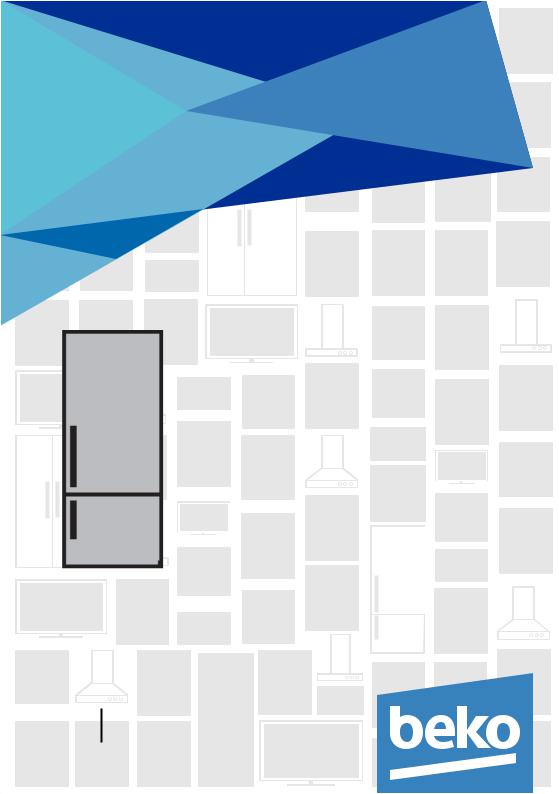
Kühlschrank/Gefrierschrank |
Bedienungsanleitung |
EWWERQWEW |
DE |
Bitte lesen Sie zuerst diese Anleitung!
Lieber Kunde,
Wirsindsicher,dassIhnendiesesProdukt,dasinmodernstenFertigungsstätten hergestellt und den strengsten Qualitätsprüfungen unterzogen wurde, lange Zeit gute Dienste leisten wird.
Wir empfehlen Ihnen, vor Inbetriebnahme des Gerätes das gesamte Handbuch durchzulesen und es anschließend aufzubewahren.
Diese Anleitung...
•hilft Ihnen, Ihr Gerät schnell und sicher zu bedienen.
•Lesen Sie die Anleitung, bevor Sie Ihr Gerät aufstellen und bedienen.
•Halten Sie sich an die Anweisungen, beachten Sie insbesondere die Sicherheitshinweise.
•Bewahren Sie die Anleitung an einem leicht zugänglichen Ort auf, damit Sie jederzeit darin nachschlagen können.
•Lesen Sie auch die weiteren Dokumente, die mit Ihrem Produkt geliefert wurden.
•Bitte beachten Sie, dass diese Anleitung eventuell auch für andere Geräte eingesetzt werden kann.
Symbole und ihre Bedeutung
In dieser Anleitung finden Sie die folgenden Symbole:
C Wichtige Informationen oder nützliche Tipps.
AWarnung vor Verletzungen oder Sachschäden.
BWarnung vor elektrischem Strom.

INHALT
1 Ihr Kühlschrank |
4 |
2 Wichtige |
|
Sicherheitshinweise |
5 |
Bestimmungsgemäßer Einsatz........... |
5 |
Allgemeine Hinweise zu Ihrer |
|
Sicherheit...................................................... |
6 |
Bei Geräten mit Wasserspender:......... |
9 |
Kinder – Sicherheit.................................... |
9 |
Erfüllung von WEEE-Vorgaben zur |
|
Entsorgung von Altgeräten: ................. |
9 |
Hinweise zur Verpackung..................... |
10 |
HC-Warnung.............................................. |
10 |
Tipps zum Energiesparen..................... |
10 |
4 Vorbereitung |
17 |
5 Nutzung des |
|
Kühlschranks |
18 |
Thermostateinstelltaste...................... |
18 |
Abtauen....................................................... |
18 |
Wasserspender......................................... |
19 |
6 Wartung und Reinigung 22 |
|
Schutz der Kunststoffflächen .......... |
23 |
7 Problemlösung |
24 |
3 Installation |
11 |
Wenn Sie den Kühlschrank versetzen |
|
möchten:...................................................... |
11 |
Vor dem Einschalten............................... |
11 |
Elektrischer Anschluss.......................... |
12 |
Verpackungsmaterialien entsorgen.12 |
|
Altgeräte entsorgen............................... |
12 |
Aufstellung und Installation................ |
13 |
Füße einstellen......................................... |
14 |
Untere Belüftung söffnungab |
|
deckung anbringen................................. |
14 |
Beleuchtung auswechseln ................. |
14 |
Turbo-Kühlungslüfter............................ |
15 |
Eisbereiter und Eisbehälter................. |
15 |
Türanschlag umkehren.......................... |
16 |
3 DE

|
1 Ihr Kühlschrank |
|
|
1 |
|
|
2 |
14 |
|
3 |
|
|
4 |
13 |
|
|
|
|
15 |
|
|
17 |
16 |
|
6 |
5 |
|
15 |
|
|
7 |
|
|
|
|
|
8 |
9 |
|
|
|
|
18 |
|
|
10 |
|
|
11 |
|
|
12 |
|
1. |
Innenbeleuchtung |
10.Tiefkühlbereich |
2. |
Thermostatknopf |
11.Lüftungsgitter |
3. |
Lüfter |
12.Einstellbare Füße an der Vorderseite |
4. |
Verstellbare Ablagen |
13.Einstellbare Türablagen |
5. |
Tauwassersammelkanal - |
14.Eierhalter |
|
Abflusskanal |
15.Flaschenablage |
6. |
Gemüsefachabdeckung |
16.Wasserspender |
7. |
Salatund Gemüsefach |
17.Kühlbereich |
8. |
Eiswürfelfach |
18.Tiefkühlbereich |
9. |
Eisbereiterschale |
|
C Abbildungen und Angaben in dieser Anleitung sind schematisch und können etwas von Ihrem Produkt abweichen. Falls Teile nicht zum Lieferumfang des erworbenen Produktes zählen, gelten sie für andere Modelle.
4 DE

|
|
Wichtige Sicherheitshinweise |
|
|
|
|
|
|
|
|
||||||||
|
2 |
|
|
|
|
|
|
|
|
|||||||||
|
Bitte lesen |
Sie die |
folgenden |
|
|
|
|
|
|
|
|
|
|
|||||
|
|
|
ACHTUNG: |
|
|
|
|
|
|
|||||||||
Hinweise aufmerksam durch. Bei |
|
|
|
|
|
|
|
|
||||||||||
|
|
In den ebensmittelaufbe- |
||||||||||||||||
Nichtbeachtung dieser Angaben |
|
|
||||||||||||||||
|
|
wahrungsfächern keine |
||||||||||||||||
kann es zu Verletzungen und |
|
|
||||||||||||||||
|
|
elektrischen |
|
|
|
|
||||||||||||
Sachschäden kommen. In diesem |
|
A |
|
|
|
|
||||||||||||
Fall |
erlöschen |
auch |
sämtliche |
|
|
Geräte verwenden, |
||||||||||||
|
|
die nicht vom |
|
|
|
|
||||||||||||
Garantie- |
und |
|
sonstigen |
|
|
|
|
|
|
|||||||||
|
|
|
Hersteller empfohlen |
|||||||||||||||
Ansprüche. |
|
|
|
|
|
|
|
|||||||||||
|
|
|
|
|
|
|
sind. |
|
|
|
|
|
|
|
||||
Originalersatzteile |
stehen für |
|
|
|
|
|
|
|
|
|
||||||||
einen Zeitraum von 10 Jahre |
|
|
WARNUNG: |
|
|
keinerlei |
||||||||||||
beginnend mit |
dem |
Kaufdatum |
|
|
Lagern |
|
Sie |
|
|
|||||||||
zur Verfügung. |
|
|
|
|
|
|
explosiven |
|
|
Substanzen |
||||||||
Bestimmungsgemäßer |
|
A |
(dazu |
|
zählen |
auch |
||||||||||||
|
Sprühdosen |
|
|
|
mit |
|||||||||||||
Einsatz |
|
|
|
|
|
|
|
brennbarem Treibmittel) im |
||||||||||
|
|
|
|
|
|
|
|
|
Gerät. |
|
|
|
|
|
|
|
||
|
|
ACHTUNG: |
|
|
|
|
|
|
|
|
|
|
|
|
|
|||
|
|
|
Stellen |
Sie |
sicher, dass |
|
|
Dieses Gerät ist für die private |
||||||||||
|
|
wenn das |
|
|
|
|
|
|||||||||||
|
|
|
|
|
|
Nutzung oder für den Gebrauch |
||||||||||||
|
|
|
Gerät in seinem |
|
|
|||||||||||||
A |
|
|
|
bei |
folgenden |
|
ähnlichen |
|||||||||||
|
|
|
Gehäuse oder platziert ist, |
|
Anwendungen |
|
|
|
konzipiert |
|||||||||
|
|
die Entlüftungsöffnungen |
|
wurden |
Personalküchen in |
|||||||||||||
|
|
nicht blockiert werden. |
|
- |
In |
|||||||||||||
|
|
|
Geschäften, Büros und anderen |
|||||||||||||||
|
|
ACHTUNG: |
|
|
|
|
||||||||||||
|
|
|
|
|
|
Arbeitsumgebungen; |
|
|
|
|||||||||
|
|
|
Um den Auftauvorgang zu |
|
|
|
|
|||||||||||
|
|
|
|
- |
In |
|
|
Bauernhöfen, |
||||||||||
|
|
beschleunigen, |
|
|
|
|
||||||||||||
|
|
|
|
Hotels, Motels |
und |
|
anderen |
|||||||||||
|
|
|
keine anderen |
|
|
|
||||||||||||
A |
|
|
|
Unterkünften, für den Gebrauch |
||||||||||||||
|
|
mechanischen Geräte oder |
|
der Kunden; |
|
|
|
|
|
|
||||||||
|
|
Geräte verwenden, die |
|
|
|
|
|
|
|
|||||||||
|
|
|
- |
Umgebungen |
|
mit |
||||||||||||
|
|
nicht vom Hersteller |
|
|
||||||||||||||
|
|
|
Übernachtung und Frühstück; |
|||||||||||||||
|
|
|
empfohlen sind. |
|
|
|||||||||||||
|
|
|
|
|
- |
Bei |
Catering |
und |
||||||||||
|
|
ACHTUNG: |
|
|
|
|
ähnlichen |
|
|
|
Non-Retail- |
|||||||
|
|
|
Dem |
Kühlmittelkreislauf |
|
Anwendungen. |
|
|
|
|
|
|
||||||
A keine Schäden |
|
|
|
|
|
|
|
|
|
|
|
|
|
|||||
|
|
|
zufügen. |
|
|
|
|
|
|
|
|
|
|
|
|
|
|
|
5 DE

Allgemeine Hinweise zu Ihrer Sicherheit
•Wenn Sie das Gerät entsorgen möchten, wenden Sie sich am besten an den autorisierten Kundendienst. Hier erhalten Sie notwendige Informationen und erfahren, welche Stellen für die Entsorgung zuständig sind.
•Bei Problemen und Fragen zum Gerät wenden Sie sich grundsätzlich an den
autorisierten Kundendienst. Ziehen Sie keine Dritten zu Rate, versuchen Sie nichts in Eigenregie, ohne den autorisierten Kundendienst davon in Kenntnis zu setzen.
•Bei Geräten mit Tiefkühlbereich: Der Verzehr von Speiseeis und Eiswürfeln unmittelbar nach der Entnahme aus dem Tiefkühlbereich ist nicht ratsam. (Dies kann zu Erfrierungen führen.)
•Bei Geräten mit Tiefkühlbereich: Bewahren Sie Getränke in Flaschen sowie Dosen niemals im Tiefkühlbereich auf. Diese platzen.
•Berühren Sie gefrorene Lebensmittel nicht mit der Hand; sie können festfrieren.
•Trennen Sie Ihren Kühlschrank vor dem Reinigen oder Abtauen vom Stromnetz.
•Verwenden Sie niemals Dampfoder Sprühreiniger
6
zum Reinigen und Abtauen Ihres Kühlschranks. Die Dämpfe oder Nebel können in Kontakt mit stromführenden Teilen geraten und Kurzschlüsse
oder Stromschläge auslösen.
•Missbrauchen Sie niemals Teile Ihres Kühlschranks (z. B. Tür) als Befestigungen oder Kletterhilfen.
•Nutzen Sie keine elektrischen Geräte innerhalb des Kühlschranks.
•Achten Sie darauf, den Kühlkreislauf
keinesfalls mit Bohroder Schneidwerkzeugen zu beschädigen. Das Kühlmittel kann herausspritzen,
wenn die Gaskanäle des Verdunsters, Rohrund Schlauchleitungen oder Oberflächenversiegelungen beschädigt werden. Dies kann zu Hautreizungen und Augenverletzungen führen.
•Decken Sie keinerlei Belüftungsöffnungen des Kühlschranks ab.
•Elektrische Geräte dürfen nur von autorisierten Fachkräften repariert werden. Reparaturen durch weniger
kompetente Personen können erhebliche Gefährdungen des Anwenders verursachen.
•Sollten Fehler oder Probleme während der Wartung
oder Reparaturarbeiten auftreten, so trennen Sie den Kühlschrank von der Stromversorgung, indem Sie
DE

die entsprechende Sicherung abschalten oder den Netzstecker ziehen.
•Ziehen Sie niemals am Netzkabel – ziehen Sie direkt am Stecker.
•Achten Sie darauf, hochprozentige Getränke stehend und mit fest verschlossenem Deckel zu lagern.
•Bewahren Sie niemals Sprühdosen mit brennbaren und explosiven Substanzen im Kühlschrank auf.
•Nutzen Sie keine mechanischen oder anderen Hilfsmittel, um das Gerät abzutauen – es sei denn, solche Hilfsmittel werden ausdrücklich vom Hersteller empfohlen.
•Dieses Produkt darf nicht von Personen (einschließlich Kindern) mit eingeschränkten physischen, sensorischen oder geistigen Fähigkeiten bedient werden, sofern sie nicht durch eine Person,
die für ihre Sicherheit verantwortlich ist, in der Bedienung des Produktes angeleitet werden.
•Nehmen Sie einen beschädigten Kühlschrank nicht in Betrieb. Wenden Sie sich bei jeglichen Zweifeln an einen Kundendienstmitarbeiter.
•Die elektrische Sicherheit des Gerätes ist nur dann gewährleistet, wenn das
hausinterne Erdungssystem den zutreffenden Normen entspricht.
•Setzen Sie das Gerät keinem Regen, Schnee, direktem Sonnenlicht oder Wind aus; dies kann die elektrische Sicherheit gefährden.
•Wenden Sie sich zur Vermeidung von Gefahren an den autorisierten Kundendienst, falls das Netzkabel beschädigt ist.
•Stecken Sie während der Installation niemals den Netzstecker ein. Andernfalls kann es zu schweren bis tödlichen Verletzungen kommen.
•Dieser Kühlschrank dient nur der Aufbewahrung von Lebensmitteln. Für andere Zwecke sollte er nicht verwendet werden.
•Das Etikett mit den technischen Daten befindet sich an der linken Innenwand des Kühlschranks.
•Schließen Sie Ihren Kühlschrank niemals an energiesparende Systeme an; dies kann den Kühlschrank beschädigen.
•Falls sich ein blaues Licht am Kühlschrank befindet, blicken Sie nicht längere Zeit mit bloßem Augen oder optischen Werkzeugen hinein.
•Bei manuell gesteuerten Kühlschränken warten Sie mindestens 5 Minuten, bevor Sie den Kühlschrank nach einem Stromausfall wieder einschalten.
•Falls Sie das Gerät an einen anderen Besitzer weitergeben, vergessen Sie nicht, die Bedienungsanleitung ebenfalls auszuhändigen.
7 DE
